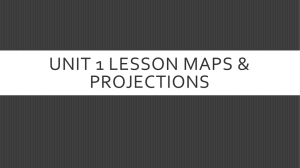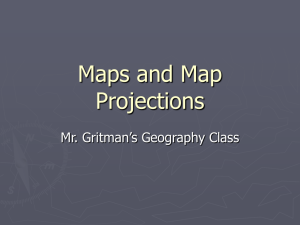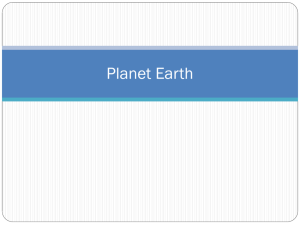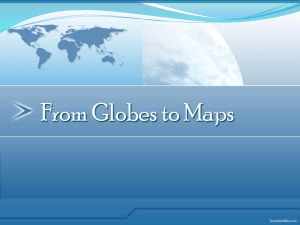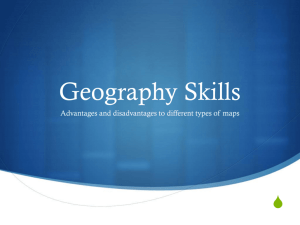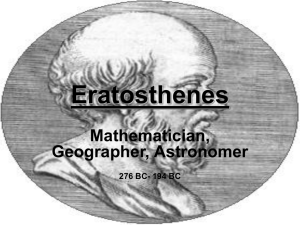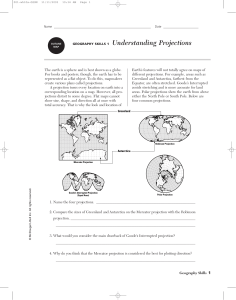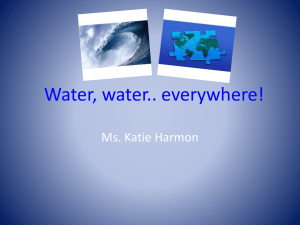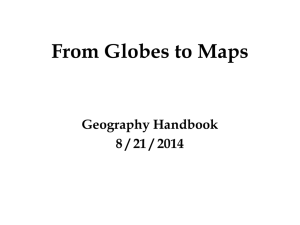Models of earth
advertisement
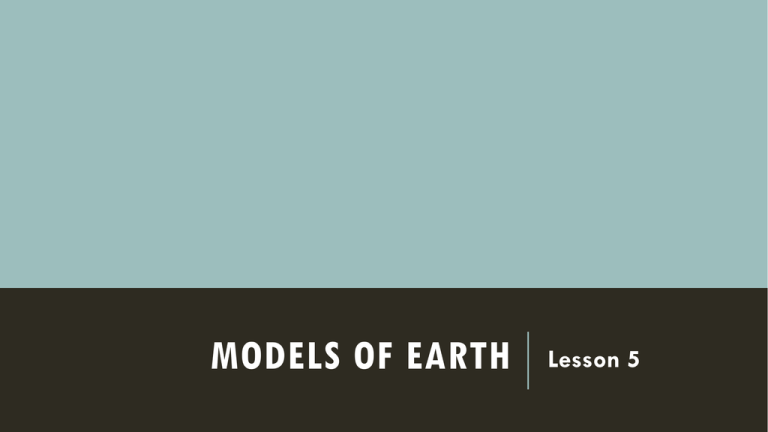
MODELS OF EARTH Lesson 5 VOCABULARY globe degree map equator map projection hemisphere symbol prime meridian key latitude scale longitude Around 240 B.C., near the day of the summer solstice, the Greek scientist Eratosthenes (276-194 B.C.) calculated Earth’s size. On that day, the sun was directly overhead at noon when viewed from the city of Syene, and its image was reflected in a well. At the same moment in Alexandria, to the north, the sun was not directly overhead. 𝟏 Instead, it appeared about 𝒐f a circle south of the point directly overhead. 𝟓𝟎 Eratosthenes reasoned that the distance between the cities by 50 and found that Earth’s circumference was 39,400 kilometers. This figure is very close to the modern measurement of 40, 075 kilometers. INTRODUCTION LET’S WATCH A VIDEO Search the Internet for more information about Eratosthenes and copy the information in your notebook. Watch this video to learn more about Eratosthenes. http://www.youtube.com/watch?v=8On7yCU1EjQ HOW DO MAPS AND GLOBES REPRESENT EARTH? Maps and globe show the shape, size, and position of features on Earth’s surface. A globe is a sphere that represents Earth’s entire surface. A map is a flat model of all or part of Earth’s surface as seen from above. Maps and globes are drawn to scale and use symbols to represent features on Earth’s surface. To show Earth’s curved surface on a flat map, mapmakers use map projections. MAP PROJECTIONS A map projection is a framework of lines that helps to transfer points on earth’s three-dimensional surface onto a flat map. Continents, oceans, islands, rivers, and lakes might appear to have somewhat different sizes and shapes due to the map projection used. A Mercator projector is just one of many projections that allow mapmakers to show a curved Earth on a flat surface. On a Mercator projection, the size and shape of landmasses become more and more distorted toward the north and south poles. LET’S LEARN MORE ABOUT MAP PROJECTIONS A Mercator projection is based on a cylinder with grid lines that has been flattened. Here is an explanation why this projection is not accurate, but it is the one used most often. To know more click here: http://www.youtube.com/watch?v=eS-C8CcNa7M QUESTIONS Copy and answer these questions in your notebook: 1. What science skills did Eratosthenes use when he estimated Earth’s circumference? 2. Why did Eratosthenes need to calculate Earth’s circumference, why didn’t he just measure it? 3. What is the summer solstice? (Find the answer in the Internet) 4. On a summer solstice, would a stick cast a shadow where you live? Why or why not? 5. What is the difference between a map and a globe? 6. How are they alike? 7. Why are models of Earth useful? 8. Why must a map use a projection to represent Earth? UNDER CONSTRUCTION SYMBOLS Mapmakers use shapes and pictures called symbols to stand for features on Earth’s surface. A symbol can represent a physical feature, such as a river, lake, mountain, or plain. A symbol can also stand for a human-made feature such as a highway, city, airport, school, or hospital. Let’s take a look to some examples on the next slide. KEYS A map’s key, or legend, is a list of all the symbols used on the map, with an explanation of their meanings. Maps also include a compass rose or north arrow. The compass rose helps relate directions on the map to directions on Earth’s surface. North usually is located at the top of the map. SCALE A map’s scale relates distance on a map to distance on Earth’s surface. Scale is often given as a ratio. For example, one unit on a map could equal 2,500 units on the ground. So I centimeter on the map would represent 2,500 centimeters, or 25 meters on real life. This scale, “one to two thousands five hundred”, would be written as a ration of “1:2,500” Let’s take a look to an example on the next slide. THERE ARE THREE TYPES OF SCALES
